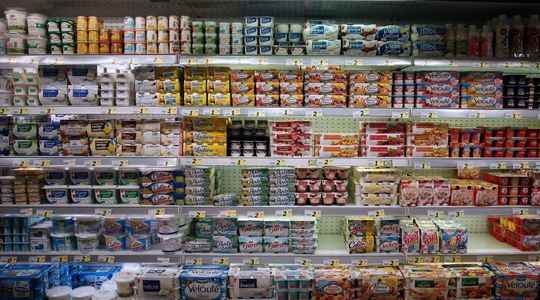The drought will leave marks on our plates. The very high heat and water stress hit French farmers and breeders hard this summer. In several sectors, the weather conditions disrupted by the global warming are likely to lead to a drop in production, with, as a result, a rise in prices in supermarkets.
Bad news for consumers which comes on top of an inflationary context linked to the war in Ukraine and soaring oil prices – inflation stands at 6.1% in France – and health already complicated. Farmers were already crushed by the jump in the cost of energy, fertilizers, wheat, corn, barley and even sunflowers. Despite inflation, they are struggling to make ends meet. “When costs increase, isn’t it normal for prices to increase? We have to teach. When farmers say that producing is more expensive, […] it’s necessary [les] hear”, protested, on August 8 on RTLChristiane Lambert, president of the FNSEA, the first agricultural union.
On the front line, dairy products – already heavily impacted by inflation – could be affected by the rise in tariffs. Having already increased by an average of 4.5% in one year, the cost of yoghurts, cheese or even milk will continue its mad dash. In question: the episodes of high heat which led to a loss of milk production. The scheme is simple: the cows eat less, which reduces the quantity of milk produced.
“We will find [du lait en supermarché cet automne]. Will we find enough? Everything will depend on how the peak of drought will unfold. I ask that the distributors play the game, that they increase the prices of our products”, declared Christiane Lambert in an interview granted on August 7 to franceinfo. In the process, she also recalled the rising cost of feed for livestock.
Lack of fodder to feed the animals
While the price of pure beef minced meat from Charal has, for example, already exploded by 30%, indicates the A3 Distrib institute, this dynamic is set to continue. Because of the pastures burned by the drought, it is impossible for the animals to feed on grasses. Two months in advance, the breeders had to draw on their stocks of fodder, vegetable matter used to feed the animals, planned for the winter. Grass production was down 21% as of July 20 from normal, at a time when dairy cows are largely feeding on pasture, according to data fromAgrestethe statistical service of the Ministry of Agriculture.
If they have to buy more, their expenses will swell because the amount of fodder is expected to soar as a result of poor harvests. Indeed, the cost of maize – a plant used to feed animals – will undoubtedly soar, this crop having been badly damaged by the aridity, and the quantity could therefore be lacking this winter. While the plant needs a lot of water, farmers did not have the option to irrigate it as they wished this summer, in order to comply with the restrictions in place.
“Save the Breeding Soldier”
Some breeders will be able to obtain fodder, but others will not have the means to feed their animals and will have to part with it, which would reduce overall production. Should we fear a possible shortage in the coming months? Ultimately, this means that “in supermarkets, there will be shelves that will be empty and it will be more complicated for the consumer to find food”, underlined on August 3 with France Blue Pascal Lerousseau, president of the Creuse chamber of agriculture. For her part, Christiane Lambert launched an alarm signal on RTL, believing that we must “save the breeding soldier in France”.
Another sector impacted: that of chickens which experienced inflation of 15%, according to INSEE which published its full overview of price trends in July, when the sector was already heavily hit by avian flu.
The centerpiece of the daily diet, the potato will meanwhile weigh down an already salty addition. Faced with the lack of water, harvests will be smaller and therefore prices will be revised upwards. In Hauts-de-France, breeders are worried about the potato harvest, a product which did not benefit from a derogation during the restrictions. “If it doesn’t rain by August 15, I risk having a 50% loss in yield,” sighed northern farmer Denis Bollengier to AFP, warning against a rise in fresh produce prices. and fries.
Another star of spring, with a sharp increase in cultivated area, French sunflowers were partly charred by the historic drought this summer. The plant, rich in protein, intended half for human consumption – as oil – and the other half for farm animals – once transformed into meal – was sown on 842,000 hectares, a level never reached since the 1990s. While sunflower oil already posted high prices – at more than three euros a bottle – this trend is set to continue.
Smaller fruit?
According to the provisional report drawn up on August 1, 2022 by Agreste, cereal production could fall by 7.6% over one year, due to a general decline in surface areas and a reduction in the yield of spring cereals. Are concerned: sunflower, rapeseed, soy or wheat.
Regarding fruit and vegetables, harvests should be good, but farmers are concerned about the impact of drought on their size and appearance. If they will be sweeter, back-to-school products could be smaller and less attractive on the shelves. Indeed, the drought prevents the fruits from growing and they will yield less to the producer. Here too, a rise in prices cannot be ruled out.
